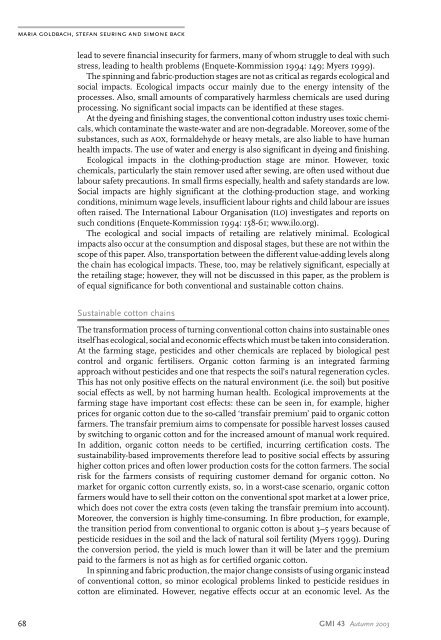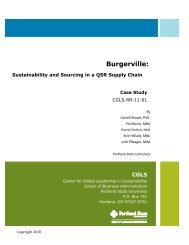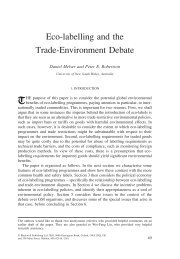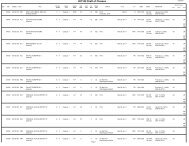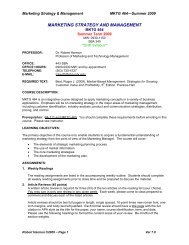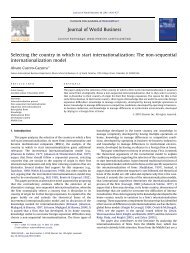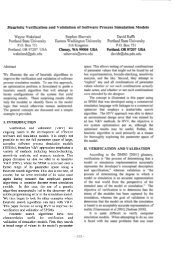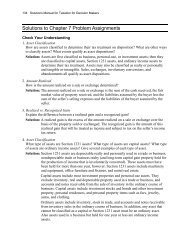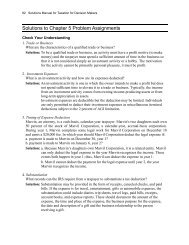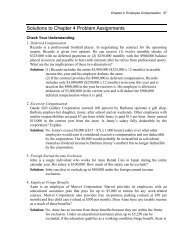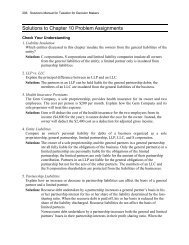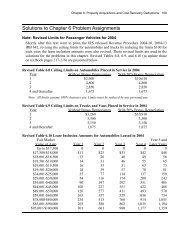Co-ordinating Sustainable Cotton Chains for the Mass Market
Co-ordinating Sustainable Cotton Chains for the Mass Market
Co-ordinating Sustainable Cotton Chains for the Mass Market
You also want an ePaper? Increase the reach of your titles
YUMPU automatically turns print PDFs into web optimized ePapers that Google loves.
maria goldbach, stefan seuring and simone back<br />
lead to severe financial insecurity <strong>for</strong> farmers, many of whom struggle to deal with such<br />
stress, leading to health problems (Enquete-Kommission 1994: 149; Myers 1999).<br />
The spinning and fabric-production stages are not as critical as regards ecological and<br />
social impacts. Ecological impacts occur mainly due to <strong>the</strong> energy intensity of <strong>the</strong><br />
processes. Also, small amounts of comparatively harmless chemicals are used during<br />
processing. No significant social impacts can be identified at <strong>the</strong>se stages.<br />
At <strong>the</strong> dyeing and finishing stages, <strong>the</strong> conventional cotton industry uses toxic chemicals,<br />
which contaminate <strong>the</strong> waste-water and are non-degradable. Moreover, some of <strong>the</strong><br />
substances, such as AOX, <strong>for</strong>maldehyde or heavy metals, are also liable to have human<br />
health impacts. The use of water and energy is also significant in dyeing and finishing.<br />
Ecological impacts in <strong>the</strong> clothing-production stage are minor. However, toxic<br />
chemicals, particularly <strong>the</strong> stain remover used after sewing, are often used without due<br />
labour safety precautions. In small firms especially, health and safety standards are low.<br />
Social impacts are highly significant at <strong>the</strong> clothing-production stage, and working<br />
conditions, minimum wage levels, insufficient labour rights and child labour are issues<br />
often raised. The International Labour Organisation (ILO) investigates and reports on<br />
such conditions (Enquete-Kommission 1994: 158-61; www.ilo.org).<br />
The ecological and social impacts of retailing are relatively minimal. Ecological<br />
impacts also occur at <strong>the</strong> consumption and disposal stages, but <strong>the</strong>se are not within <strong>the</strong><br />
scope of this paper. Also, transportation between <strong>the</strong> different value-adding levels along<br />
<strong>the</strong> chain has ecological impacts. These, too, may be relatively significant, especially at<br />
<strong>the</strong> retailing stage; however, <strong>the</strong>y will not be discussed in this paper, as <strong>the</strong> problem is<br />
of equal significance <strong>for</strong> both conventional and sustainable cotton chains.<br />
<strong>Sustainable</strong> cotton chains<br />
The trans<strong>for</strong>mation process of turning conventional cotton chains into sustainable ones<br />
itself has ecological, social and economic effects which must be taken into consideration.<br />
At <strong>the</strong> farming stage, pesticides and o<strong>the</strong>r chemicals are replaced by biological pest<br />
control and organic fertilisers. Organic cotton farming is an integrated farming<br />
approach without pesticides and one that respects <strong>the</strong> soil’s natural regeneration cycles.<br />
This has not only positive effects on <strong>the</strong> natural environment (i.e. <strong>the</strong> soil) but positive<br />
social effects as well, by not harming human health. Ecological improvements at <strong>the</strong><br />
farming stage have important cost effects: <strong>the</strong>se can be seen in, <strong>for</strong> example, higher<br />
prices <strong>for</strong> organic cotton due to <strong>the</strong> so-called ‘transfair premium’ paid to organic cotton<br />
farmers. The transfair premium aims to compensate <strong>for</strong> possible harvest losses caused<br />
by switching to organic cotton and <strong>for</strong> <strong>the</strong> increased amount of manual work required.<br />
In addition, organic cotton needs to be certified, incurring certification costs. The<br />
sustainability-based improvements <strong>the</strong>re<strong>for</strong>e lead to positive social effects by assuring<br />
higher cotton prices and often lower production costs <strong>for</strong> <strong>the</strong> cotton farmers. The social<br />
risk <strong>for</strong> <strong>the</strong> farmers consists of requiring customer demand <strong>for</strong> organic cotton. No<br />
market <strong>for</strong> organic cotton currently exists, so, in a worst-case scenario, organic cotton<br />
farmers would have to sell <strong>the</strong>ir cotton on <strong>the</strong> conventional spot market at a lower price,<br />
which does not cover <strong>the</strong> extra costs (even taking <strong>the</strong> transfair premium into account).<br />
Moreover, <strong>the</strong> conversion is highly time-consuming. In fibre production, <strong>for</strong> example,<br />
<strong>the</strong> transition period from conventional to organic cotton is about 3–5 years because of<br />
pesticide residues in <strong>the</strong> soil and <strong>the</strong> lack of natural soil fertility (Myers 1999). During<br />
<strong>the</strong> conversion period, <strong>the</strong> yield is much lower than it will be later and <strong>the</strong> premium<br />
paid to <strong>the</strong> farmers is not as high as <strong>for</strong> certified organic cotton.<br />
In spinning and fabric production, <strong>the</strong> major change consists of using organic instead<br />
of conventional cotton, so minor ecological problems linked to pesticide residues in<br />
cotton are eliminated. However, negative effects occur at an economic level. As <strong>the</strong><br />
68 GMI 43 Autumn 2003


